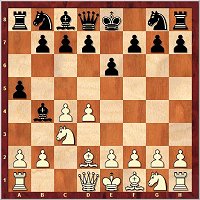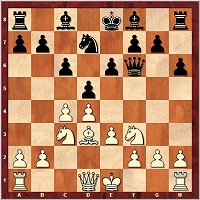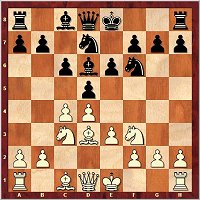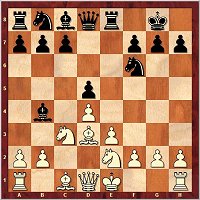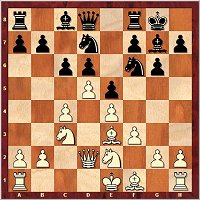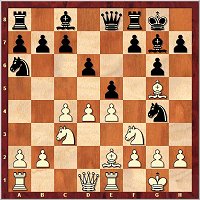|

| Introductory videos
Karsten Müller starts his video introduction to this issue with two games in the Grünfeld Defence from Wijk aan Zee (Kramnik against L'Ami and Shirov versus Vachier-Lagrave). The grandmaster from Hamburg has also picked out two of the 14 openings articles and introduces you to the essential of what is said in Martin Breutigam’s repertoire suggestion (Scandinavian with 3...Qd6 and 5...c6) and Leonid Kritz' analyses of sub-variations in the Two Knights Defence (1.e4 e5 2.Nf3 Nc6 3.Bc4 Nf6 4.Ng5 d5 5.exd5 Nd4 or 5...b5), which should be particularly attractive to club players. |

| GM Dorian Rogozenco heads his retrospective over the latest tournament highlights with the most important theoretical innovations from Wijk aan Zee. Ponomariov’s innovation with 15.a5 in the King’s Indian (Sämisch) should find a good foothold in opening theory, as should Giri’s 12...c5 in the Semi-Slav (Moscow Variation). He then pays tribute to Nakamura’s performance in Wijk aan Zee and demonstrates the latter’s ability through his endgame victory over Shirov. Other high points from the Tata Steel Tournament which Rogozenco presents to you in his first video are Anand’s victory over Wang Hao and three very different games played by Carlsen. |

| In the second videoRogozenco introduces you to some pearls from the very strong open tournaments in Gibraltar and Moscow (Moscow Open and Aeroflot Open). As an example of Ivanchuk’s fantastic performance in Gibraltar, he explains the latter’s brilliant endgame mating attack against GM Lafuente. A lesson for all those who would like to learn how to convert a slight positional advantage!
Le Quang Liem managed the tour de force of winning the Aeroflot Open for the second time in succession. On the DVD the Vietnamese GM himself annotates two of his games (see below). On his video Rogozenco reviews the decisive moments. |
| 15.01.-30.01.2011 
A new US star?
Hikaru Nakamura
| Wijk aan Zee (A-Tournament) Up till now Hikaru Nakamura’s image was that of a gambler. If you take a look at the development of his Elo curve, then that is not very easy to recognise because it heads steadily upwards and has recently been steering towards 2800. His victory at what is perhaps the strongest tournament of the year in Wijk aan Zee came however as something of a sensation. In Carlsen, Anand, Kramnik and Aronian there were perhaps too many top players in the starting blocks to expect the US-American to top the bill.
In the early rounds Nakamura let fly, e.g. with victories over Grischuk and Shirov, then maintained his place in the top group with further wins over the two Dutch players L'Ami and Smeets and took sole lead for the first time in round 11. In the final rounds, only Vishy Anand could have contested his victory. But the world champion could find no way to win his games and once more had to content himself with a second place in a top tournament. |
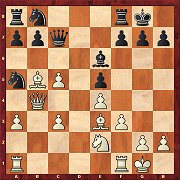
Anand,V - Wang Hao
Position before 16.Nd4
| All the games from Wijk aan Zee (including those from the B-group) can be found on the DVD. Two of those who were pipped at the post, Anand and Kramnik, have each annotated one of their best games for this issue.
Vishy Anand begins the analysis of his game against Wang Hao with a reference to the latter’s game against Kramnik only two rounds previously. In it the Chinese player had also chosen 13...Na5 in the Sämisch Variation of the Nimzo-Indian and had done well with it. But Anand had simply done some preparation. With 14.Qb4 he deviated only very subtly from Kramnik’s 14.Qa4, but Wang Hao promptly fell into the trap with the optimistic setup 14...e5 and 15...Be6 (see diagram). Next came the knight sacrifice 16.Nd4, and after 16...exd4 17.cxd4 Black already has serious practical problems. Click on the link under the diagram and play through this powerfully executed game with the comments of the world champion.
|
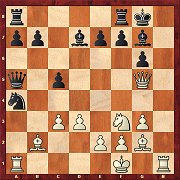
Kramnik,V - L'Ami,E
Position after 17.Qd2-g5
| Vladimir Kramnik carried out a faultless attacking victory over Erwin L'Ami. At first glance, the ex world champion’s choice of opening did not look particularly aggressive: playing against a Grünfeld Defence he only advanced his d-pawn as far as d3 and thus deprived his opponent of the classical target for his attack. In the analysis Kramnik starts his criticism with move 7 by L'Ami. Instead of quick castling, he recommends that Black should first develop his pieces. The course of the game shows why. With 10.h4 Kramnik laid his cards on the table and continued the attack with 13.h5 and 14.hxg6. The move 17.Qg5 (see diagram) exploits two pins simultaneously to bring his queen into the attack and at the same time to cut off the black queen from the kingside. There followed 17...Qb6 18.Qh4 Rfe8. With what move did Kramnik now decide the game? |
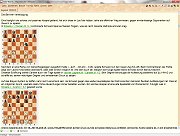
| The Romanian GM Mihail Marin presents in his openings report all the new ideas and trends from the world’s top players. Amongst the major themes are after 1.e4 the Ruy Lopez (e.g. Shirov’s “Tkachiev” System and the Berlin), the Najdorf (the Classical System with 6.Be2) and the Caro-Kann (above all the popular Advance Variation). In Wijk aan Zee White did better with 1.d4 than with 1.e4. There it was above all the Grünfeld Defence in its various lines (e.g. the Fianchetto and Exchange Variations), but there are interesting new ideas in many other systems too, such as, e.g., in the Semi-Slav (two early innovations by Anish Giri). |

Carlsen,M - Nepomniachtchi
Position after 25...Qd7
| Magnus Carlsen once again had his ups and downs in Wijk. After two draws at the start, he lost hands down with White to Anish Giri’s Grünfeld Defence. It was only victories against the other two Dutch players that brought him back into contention, and when he defeated Nakamura in round 8, he was again a force to be reckoned with. But his next and decisive setback came soon after when he went down with White to Ian Nepomniachtchi. Thanks above all to his powerful bishop on b7, the young Russian took the initiative in the Sicilian Najdorf Variation with 6.Be2 after a piece of carelessness by Carlsen. In the position in the diagram he slipped in the quiet move 25...Qd7 (26.fxe4 would be punished by 26...Ra4). Carlsen did continue accurately, but finally had to surrender the exchange and the game was decided after the loss of the passed pawns on the queenside. Ian Nepomniachtchi has analysed all the phases of this exciting game in detail on the DVD. |
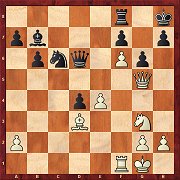
Shirov - Vachier Lagrave
Position after 22.Ne2-g3
| His first appearance in Wijk aan Zee could not have worked out much better for the young French player Maxime Vachier-Lagrave. One loss was finally counter-balanced by three victories. He has annotated on the DVD his win with Black over the once more unfortunate Alexei Shirov. In a Grünfeld Defence, Vachier-Lagrave first surprised his opponent with the somewhat rare 10...Na5, and at first they followed the opening game from the WCh match Topalov-Anand. The French player deviated with 15...Bb7 and introduced a new idea in the form of 18...Rc8: Black does not stop his opponent from advancing his f-pawn and hopes in return to get sufficient play for his pieces. The decisive mistake was made by Shirov with the move 22.Ng3 (see diagram). Because after the surprising reply 22...Rg8 the knight is simply misplaced. The French player then brought his knight to the effective post on e5 and continued with the decisive advance of his d-pawn. |
| 15.01.-30.01.2011 
Back to the old?
Luke McShane
| Wijk aan Zee (B-Tournament) A category 17 B-Tournament is only possible in Wijk. With Wojtaszek, Navara, Fressinet and Efimenko there were in the field four players with an Elo rating above 2700. Victory went to one of the "newcomers" in the widest possible sense of the term: Luke McShane only just properly returned to professional chess a few months ago. As in London he also came up with some courageous chess and was rewarded with a shared first place. He and David Navara will be both able to measure themselves against the world’s best in next year’s A-Tournament. |

Li,C - McShane,L
Position after 16.Bb5
| McShane laid the foundations for his success right at the start. His first round victory over Wouter Spoelman was followed by two further wins against Chao Li and Vladislav Tkachiev. The English player was successful against the Chinese one in a King’s Indian with h3. After McShane’s 5...a6 and 8...e6 the protagonists were already almost in virgin theoretical territory, and Li commenced an open struggle with the pawn sacrifice 16.Bb5 (see diagram). McShane picked up the gauntlet and chose in 16...Nxe4 the most complicated reply. After the exchange of queens the powerful white pieces developed massive pressure in conjunction with the rook on the e-file, But the English player’s position stood up to it. McShane finally exploited a moment of carelessness by his opponent (33.a5) to simplify the position and to liquidate to a won endgame. |
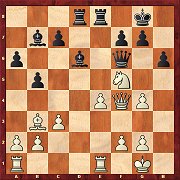
McShane,L - Tkachiev,V
Position after 23...Bd6
| The following day McShane opted for a less explosive opening (8.d3 in the Ruy Lopez Archangelsk Variation) against the European champion of 2007, Vladislav Tkachiev. In his analysis he explains why he likes playing the Ruy Lopez with White and why he considers the placing of the bishop on b7 in this specific variation to be less than optimal. After winning a pawn on f4 McShane decided in the position on the board on the left to liquidate to “a position with a secure advantage” and captured on h6 with the knight. But after 24...Qxh6 25.Bxf7+ Kh7 26.Qxh6+ Kxh6 27.Bxe8 Rxe8 28.f3 there arose an extremely unusual position, in which White has a rook and three pawns for the bishop pair. The retrospective view of the future tournament winner is critical, because although he managed to decide the game in his favour after painstaking manoeuvring McShane feels that White’s advantage after this liquidation is pretty dubious. |
| 25.01.-03.02.2011 
Vassily Ivanchuk
A rock amongst the breakers
| Gibraltar Chess Festival There are not many of the top players who are bold enough to enter a very strong open tournament. When you get down to it, the opposition consists mainly of experienced grandmasters and the pressure to win is also enormous, especially when you take into account the effect it could have on your Elo rating. Vassily Ivanchuk was not put off by this and went into this year’s Gibraltar Masters as the top favourite. However, it was another older star who set the pace at the beginning: Nigel Short won his first five games, against, among others, the two Kosintseva sisters and Pia Cramling. But then in round 6 he came up against Ivanchuk, and his series of victories came to an abrupt end. With Black, the English player really set about his opponent right from the opening, but he was biting on granite. At the end he even got himself entangled in the Ukrainian’s mating net. Following this key game it was Ivanchuk who dictated the pace and conceded only one more half point against Mikhalevski. At the end he had notched up a fantastic 9 out of 10 and an Elo performance of 2968. And Short also rapidly recovered from his defeat and finished the tournament only half a point behind in second place thanks to another series of wins in the final rounds. |

Mikhalevski,V - Ivanchuk
Position after 32.Nd3 | On this DVD you will find three games by Vassily Ivanchuk with extensive analysis. However, it is not his analysis but that of his opponents. But that too has its special charm of course. Through the explanations of Caruana, Mikhalevski and Roiz you will be able to construct a picture of Ivanchuk’s magnificent playing style.
In the game Mikhalesvki-Ivanchuk there was a violent exchange of pieces in the King’s Indian. As Mikhalevski makes clear in his analysis, in this high class game both sides were walking along a very narrow path but both players kept on finding amazing resources. An example of that is Ivanchuk’s intermediate move 32...gxh3 in the position on the board on the left. Quite logically the game ended in a draw by perpetual check.
|

Ivanchuk,V - Roiz,M
Position after 23.Qe3
| In the next round Ivanchuk confronted the Israeli GM Michail Roiz in a Semi-Slav with the rare move 5.Qd3. But Roiz came out of the opening well and thought himself to be reasonably safe after the tactical capture 19...Nxf4. But, as he admits in his analysis, this liquidation was based on a wrong evaluation of the resulting position. It was only when he reached the position on the board on the left after 23.Qe3 that Roiz realised that White can create a safe shelter for his king with the move f2-f3, whereas the black king has always got to be on the lookout for attacks by the strong white knight. That was exactly what did it at the end. After an exchange of rooks Ivanchuk took command on the queenside and with the help of a knight fork on e7 he won the decisive extra pawn. Click on the link under the diagram and enjoy the amazingly easy way in which Ivanchuk completed his victory. |
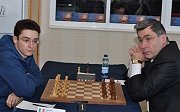
Caruana annotates:
Caruana - Ivanchuk
| Fabiano Caruana was for a long time amongst those pursuing most closely the dynamic duo. In the last round but one he had the chance to join the leaders when playing with White against Ivanchuk. But to do so he would have required a victory. Caruana tried to get one with the Ruy Lopez Exchange Variation. Invanchuk chose the setup with 5...f6 and followed up with an innovation after 6...Bg4, namely 7...Qe7. In his analysis the Italian player criticises himself for having chosen at this point too slow a plan. In fact, after Ivanchuk’s 11...Qe6 he already found himself struggling to achieve equality. But that too went wrong. The Ukrainian not only took the initiative, but he also brought the white position to a state of paralysis with the help of a series of quiet and subtle moves. And finally, in a bad position, the c-pawn was also lost, the deciding moment. In his analysis, Caruana does not mince his words and all he says indicates his great respect for his opponent’s subtle positional play. |

Nadezhda Kosintseva annotates
| In Gibraltar the ladies also provided some entertainment in the best sense of the term. For example, at the start Nadezhda Kosintseva kept up with Nigel Short step for step and after four victories the leading duo consisted of her and the English player. But in the long run it was not sufficient for one of the top placings, though she also gave a good account of herself against GMs such as Georgiev and Adams. On the DVD the Russian annotates her victory over the Indian GM Chanda Sandipan. Her sharp handling of the Najdorf Variation and the ingenious way she found to win in the endgame (25.Rb1) are things you must not miss. Kosintseva,N - Sandipan,C
The best place was obtained by Nana Dzagnidze on 7 points and 6th in the order of merit on tie-break. The young Georgian grandmaster managed, for example, to notch up two wins over players who were almost over the 2700 mark (Vallejo Pons and Sasikiran). Of course, you will also find both games on the DVD. |
| 08.02.-16.02.2011 
Le Quang Liem
defends his title
| Aeroflot Open Moscow The previous year’s winner Le Quang Liem was defending his title and once again won the Aeroflot Open. The Vietnamese player got off to an explosive start with four wins (including one against Gata Kamsky) and two rounds before the end he was already looking like the victor. But then he had to admit defeat against Cheparinov’s attack in the King’s Indian. Despite that a draw in the final round sufficed for victory in the tournament because the Bulgarian who was on equal points lost his game as White to Nikita Vitiugov. Vitiugov and Tomashevsky did then draw level on points with Le Quang Liem (6.5 out of 9) but had an inferior tie-break score. |
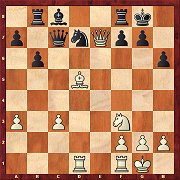
Le Quang,L - Xiu,D
Position after 18.Qe2-e7
| The Vietnamese player (who has just turned 20) has annotated on the DVD two of his early victories in Moscow. Against the untitled Chinese player Deshun Xiu (Elo 2508) Le Quang Liem had to display his ability in the Ragozin Defence to the Queen’s Gambit. The Chinese player tried out the new 10...c5 so as to immediately nibble away at White’s centre. Possibly too early, because the Vietnamese thwarted Black’s plan of development with the breakthrough 16.d5 and completely paralysed the black pieces (see diagram after 18.Qe7). Xiu saw himself forced to surrender his two minor pieces for a rook and a pawn after 18...Qxc3 19.Be4 Qc5, in the hope of being able to hold the position. But Le Quang Liem went on to win an exchange and finally liquidated to a winning rook ending. Play through the game and let the tournament victor from Moscow explain all the subtleties in the opening. |
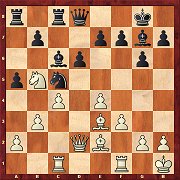
Lenic,L - Le Quang,L
Position after 17...Qd8 | In his next round game against the Slovenian GM Luka Lenic Le Quang Liem seized the sole lead and demonstrated how to be successful with Black in the Sicilian Defence when faced with the Maroczy setup. In the position on the board on the left the text move 17...Qd8 is the start of a long-term strategic manoeuvre: Black wants to exchange dark-squared bishops and to prepare that with the help of the moves h5, Kh7, Qf8 and finally Bh6. That is almost exactly what happened in the game. After the exchange of bishops, the Vietnamese thoroughly outplayed his opponent on the dark squares and ended the game in remarkable fashion with the tactical trick 42...Sh1 (see Rogozenco’ssecond introductory video). |
| 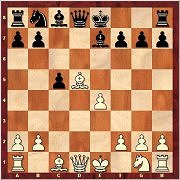
Opening Trap
Position after 8...Be7
What should be done, or also – what should not be played?
| From the opening trap to the endgame study Training in ChessBase Magazine begins with the very first moves and takes in all the phases of a game of chess. The 14 up-to-date Openings articles with numerous ideas and suggestions for your repertoire can be foundhereor above amongst the links.This time Rainer Knaak’s opening trap (including its Fritztrainer video) contains a a trap from the Queen’s Gambit Accepted, see the diagram. The openings articles of Leonid Kritz (French Winawer Variation), Dejan Bojkov (Ruy Lopez Exchange Variation), Valeri Lilov (King’s Indian Attack) and Adrian Mikhalchishin (Sicilian Paulsen) have also been produced in video format. You will find these videos and another clip by Nigel Davies in Chess Media format in the column Fritztrainer. Peter Wells’ subject in his Strategy-columnis called: "Doubled f-pawns in front of the castled king: Part 1 – The central significance of the safety of the king". In Daniel King’s long-running favourite Move by Movehe deals with a game in the Grünfeld Defence. And in the columns for Tactics and EndgamesOliver Reeh and Karsten Müller have once more selected for you all that is best in the latest tournament practice. |

























